Neural Network
> Artificial Intelligence
> Cognitive Architecture
Neural network gets an idea of number without counting - tech - 20 January 2012. AN ARTIFICIAL brain has taught itself to estimate the number of objects in an image without actually counting them, emulating abilities displayed by some animals including lions and fish, as well as humans.
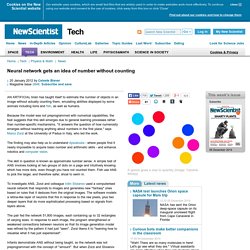
Because the model was not preprogrammed with numerical capabilities, the feat suggests that this skill emerges due to general learning processes rather than number-specific mechanisms. "It answers the question of how numerosity emerges without teaching anything about numbers in the first place," says Marco Zorzi at the University of Padua in Italy, who led the work. The finding may also help us to understand dyscalculia - where people find it nearly impossible to acquire basic number and arithmetic skills - and enhance robotics and computer vision. The skill in question is known as approximate number sense.
Stanford's Artificial Neural Network Is The Biggest Ever. Stanford Researchers and Google Create World's Largest Artificial Neural Network. Google and Neural Networks: Now Things Are Getting REALLY Interesting,…
Back in October 2002, I appeared as a guest speaker for the Chicago (Illinois) URISA conference.
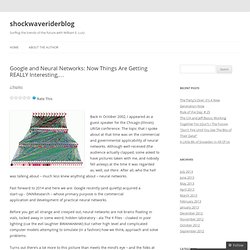
The topic that I spoke about at that time was on the commercial and governmental applicability of neural networks. Although well-received (the audience actually clapped, some asked to have pictures taken with me, and nobody fell asleep) at the time it was regarded as, well, out there.
Google scientist Jeff Dean on how neural networks are improving everything Google does. Simon Dawson Google's goal: A more powerful search that full understands answers to commands like, "Book me a ticket to Washington DC.

" Jon Xavier, Web Producer, Silicon Valley Business Journal If you've ever been mystified by how Google knows what you're looking for before you even finish typing your query into the search box, or had voice search on Android recognize exactly what you said even though you're in a noisy subway, chances are you have Jeff Dean and the Systems Infrastructure Group to thank for it. As a Google Research Fellow, Dean has been working on ways to use machine learning and deep neural networks to solve some of the toughest problems Google has, such as natural language processing, speech recognition, and computer vision. In this exclusive Q&A, he talks about his work and how it's making Google more powerful and easy to use. Q: What does your group do at Google?
A: We in our group are trying to do several things.
Researchers Create Artificial Neural Network from DNA. 5inShare Scientists at the California Institute of Technology (Caltech) have successfully created an artificial neural network using DNA molecules that is capable of brain-like behavior.
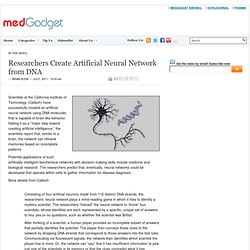
Hailing it as a “major step toward creating artificial intelligence,” the scientists report that, similar to a brain, the network can retrieve memories based on incomplete patterns. Potential applications of such artificially intelligent biochemical networks with decision-making skills include medicine and biological research. The researchers predict that, eventually, neural networks could be developed that operate within cells to gather information for disease diagnosis.
Google X’s Artificial Neural Networks Learns to Identify Cats. New Techniques from Google and Ray Kurzweil Are Taking Artificial Intelligence to Another Level. In a Big Network of Computers, Evidence of Machine Learning. ARTIFICIAL NEURAL NETWORKS - A neural network tutorial. Brain Project Comparison. Synaptic Web. 8- Global Brain. A Brain Cell is the Same as the Universe. A Brain Cell is the Same as the Universe by Cliff Pickover, Reality Carnival Physicists discover that the structure of a brain cell is the same as the entire universe.
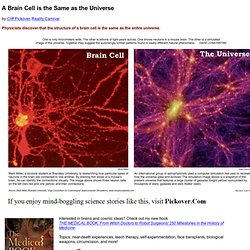
Image Source Return to Reality Carnival.
Universe Grows Like A giant Brain. The universe may grow like a giant brain, according to a new computer simulation.
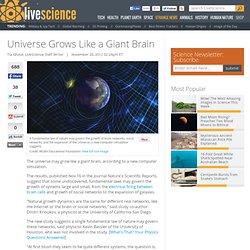
The results, published Nov.16 in the journal Nature's Scientific Reports, suggest that some undiscovered, fundamental laws may govern the growth of systems large and small, from the electrical firing between brain cells and growth of social networks to the expansion of galaxies. "Natural growth dynamics are the same for different real networks, like the Internet or the brain or social networks," said study co-author Dmitri Krioukov, a physicist at the University of California San Diego. The new study suggests a single fundamental law of nature may govern these networks, said physicist Kevin Bassler of the University of Houston, who was not involved in the study. [What's That?
TO UNDERSTAND IS TO PERCEIVE PATTERNS. A Neuroscientist's Radical Theory of How Networks Become Conscious - Wired Science.
It’s a question that’s perplexed philosophers for centuries and scientists for decades: Where does consciousness come from?
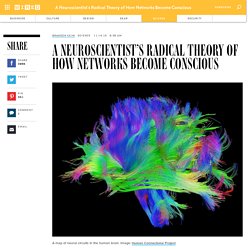
We know it exists, at least in ourselves. But how it arises from chemistry and electricity in our brains is an unsolved mystery. Neuroscientist Christof Koch, chief scientific officer at the Allen Institute for Brain Science, thinks he might know the answer. According to Koch, consciousness arises within any sufficiently complex, information-processing system. All animals, from humans on down to earthworms, are conscious; even the internet could be.
Networks, Crowds, and Markets: A Book by David Easley and Jon Kleinberg. In recent years there has been a growing public fascination with the complex "connectedness" of modern society.

This connectedness is found in many incarnations: in the rapid growth of the Internet and the Web, in the ease with which global communication now takes place, and in the ability of news and information as well as epidemics and financial crises to spread around the world with surprising speed and intensity. These are phenomena that involve networks, incentives, and the aggregate behavior of groups of people; they are based on the links that connect us and the ways in which each of our decisions can have subtle consequences for the outcomes of everyone else. Networks, Crowds, and Markets combines different scientific perspectives in its approach to understanding networks and behavior. The book is based on an inter-disciplinary course that we teach at Cornell. The book, like the course, is designed at the introductory undergraduate level with no formal prerequisites.
Synaptic Web. Stay updated about the Synaptic Web on Twitter via @SynapticWeb The Synaptic Web By Khris Loux, Eric Blantz, Chris Saad and you...
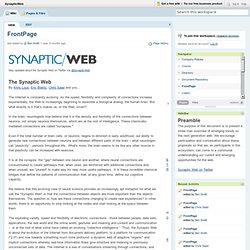
The Internet is constantly evolving. As the speed, flexibility and complexity of connections increase exponentially, the Web is increasingly beginning to resemble a biological analog; the human brain.
Crowd Computing and The Synaptic Web. A couple of days ago David Gelernter – a known Computer Science Visionary who famously survived an attack by the Unabomber – wrote a piece on Wired called ‘The End of the Web, Search, and Computer as We Know It’.
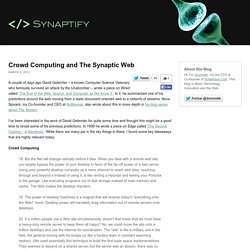
In it, he summarized one of his predictions around the web moving from a static document oriented web to a network of streams. Nova Spivack, my Co-founder and CEO at Bottlenose, also wrote about this in more depth in his blog series about The Stream. I’ve been interested in the work of David Gelernter for quite some time and thought this might be a good time to revisit some of his previous predictions.
In 1999 he wrote a piece on Edge called ‘The Second Coming – A Manifesto’. While there are many pie in the sky things in there, I found some key takeaways that are highly relevant today: Crowd Computing 18. In order to make software and apps more intelligent, there is a vast amount of computation that needs to be done.
Collective Intelligence in Neural Networks and Social Networks « 100 Trillion Connections. Context for this post: I’m currently working on a social network application that demonstrates the value of connection strength and context for making networks more useful and intelligent.
Connection strength and context are currently only rudimentarily and mushily implemented in social network apps. This post describes some of the underlying theory for why connection strength and context are key to next generation social network applications.
The Synaptic Web. The Ready Application of Neural Networks. Neural networks (in theory) existed since the 1950's, but it wasn't until the mid-1980's thatalgorithms became sophisticated enough for real neural network applications. McCulloch and Pitts groundbreaking work, “
Artificial neural network.
An artificial neural network is an interconnected group of nodes, akin to the vast network of neurons in a brain. Here, each circular node represents an artificial neuron and an arrow represents a connection from the output of one neuron to the input of another. For example, a neural network for handwriting recognition is defined by a set of input neurons which may be activated by the pixels of an input image. After being weighted and transformed by a function (determined by the network's designer), the activations of these neurons are then passed on to other neurons.
DARPA SyNAPSE Program. Last updated: Jan 11, 2013. Neurona@Home. Fast Artificial Neural Network Library (FANN)
Neuralview [OProj - Open Source Software]
Recurrent neural network. A recurrent neural network (RNN) is a class of neural network where connections between units form a directed cycle.
This creates an internal state of the network which allows it to exhibit dynamic temporal behavior.
Hamache.pdf. Learning and neural networks. Emergent. [1302.3943] Interplay between Network Topology and Dynamics in Neural Systems. IBM simulates 530 billon neurons, 100 trillion synapses on supercomputer. Cells...
The BioRC Biomimetic Real-Time Cortex Project. Les architectures neuromorphiques. Les ordinateurs sont vraiment loin d'être les seuls systèmes capables de traiter de l'information. Les automates mécaniques furent les premiers à en être capables : les ancêtres des calculettes étaient bel et bien des automates basés sur des pièces mécaniques, et n'étaient pas programmables.
Par la suite, ces automates furent remplacés par les circuits électroniques analogiques et numériques non-programmables. La suite logique fût l'introduction de la programmation : l'informatique était née. De nos jours, de nouveaux types de circuits de traitement de l’information ont vu le jour. On peut citer des circuits électroniques, qui sont souvent reconfigurables, mais pas programmables. Dans ce qui va suivre, nous allons voir :
IBM Research creates new foundation to program SyNAPSE chips. Neural Networks. Introduction aux Réseaux de Neurones Artificiels Feed Forward. Plongeons-nous dans l'univers de la reconnaissance de formes. Plus particulièrement, nous allons nous intéresser à la reconnaissance des chiffres (0, 1, ..., 9).
Imaginons un programme qui devrait reconnaître, depuis une image, un chiffre. On présente donc au programme une image d'un "1" manuscrit par exemple et lui doit pouvoir nous dire "c'est un 1". Supposons que les images que l'on montrera au programme soient toutes au format 200x300 pixels. On aurait alors 60000 informations à partir desquelles le programme déduirait le chiffre que représente cette image. De façon plus générale, un réseau de neurone permet l'approximation d'une fonction.
Dans la suite de l'article, on notera un vecteur dont les composantes sont les n informations concernant un exemple donné. Voyons maintenant d'où vient la théorie des réseaux de neurones artificiels. Comment l'homme fait-il pour raisonner, parler, calculer, apprendre... ?
A Non-Mathematical Introduction to Using Neural Networks. What is neural network? - Definition from Whatis. NeuroSolutions: What is a Neural Network?
Introduction to Neural Networks. AIspace. An Introduction to Neural Networks.










